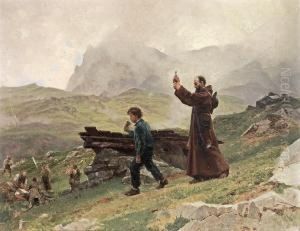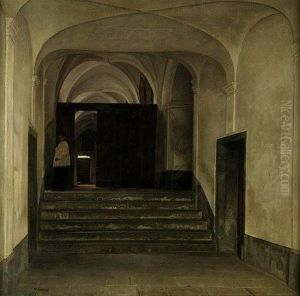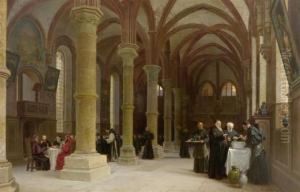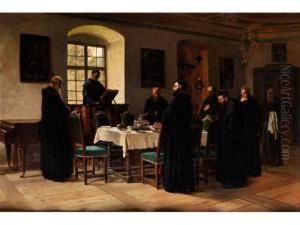Wilhelm Ludwig Fr. Riefstahl Paintings
Wilhelm Ludwig Friedrich Riefstahl was a German painter and illustrator known for his historical and genre paintings. Born on February 19, 1827, in Neu-Brandenburg, Mecklenburg-Vorpommern, Germany, Riefstahl grew up in a time when the romantic spirit was influencing all forms of art and literature in Germany. His early education and initial exposure to art would have taken place against this backdrop of romantic idealism.
Riefstahl's artistic journey began with his studies at the Academy of Arts in Berlin. During his time there, he was influenced by the works of prominent German artists such as Karl Friedrich Schinkel, whose architectural designs and history paintings were of particular significance during the early 19th century. Riefstahl's style was also likely affected by the Nazarene movement, which sought to revive honesty and spirituality in Christian art.
Throughout his career, Riefstahl was known for his meticulous attention to detail and his ability to bring historical scenes to life on canvas. His works often depicted scenes from the Middle Ages, renaissance, and reformation, showcasing his interest in the past and his skill in historical research. He was particularly adept at capturing the nuances of period clothing, architecture, and ambiance, which lent an air of authenticity to his paintings.
Riefstahl's paintings received recognition during his lifetime, and he became a respected figure in the German art world. Unfortunately, compared to some of his contemporaries, Riefstahl did not achieve the same level of lasting fame, and today he is not as widely known outside of certain art historical circles. Nonetheless, his contributions to the genre of historical painting remain significant, as they reflect the 19th-century preoccupation with history and the past.
Wilhelm Ludwig Friedrich Riefstahl died on November 21, 1888. Despite the relative obscurity in modern times, his works can be seen as a testament to the rich tapestry of historical painting in 19th-century Germany and are preserved in various art collections and museums. His legacy persists through the detailed and evocative scenes he left behind, offering a window into the artist's vision of historical events and the romantic sensibilities of his era.



